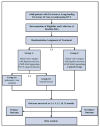Designing comparative effectiveness trials of surgical ablation for atrial fibrillation: experience of the Cardiothoracic Surgical Trials Network
- PMID: 21616507
- PMCID: PMC4052450
- DOI: 10.1016/j.jtcvs.2011.04.010
Designing comparative effectiveness trials of surgical ablation for atrial fibrillation: experience of the Cardiothoracic Surgical Trials Network
Abstract
Objective: Since the introduction of the cut-and-sew Cox maze procedure for atrial fibrillation, there has been substantial innovation in techniques for ablation. Use of alternative energy sources for ablation simplified the procedure and has resulted in dramatic increase in the number of patients with atrial fibrillation treated by surgical ablation. Despite its increasingly widespread adoption, there is lack of rigorous clinical evidence to establish this procedure as an effective clinical therapy.
Methods: This article describes a comparative effectiveness randomized trial, supported by the Cardiothoracic Surgical Clinical Trials Network, of surgical ablation with left atrial appendage closure versus left atrial appendage closure alone in patients with persistent and long-standing persistent atrial fibrillation undergoing mitral valve surgery. Nested within this trial is a further randomized comparison of 2 different lesions sets: pulmonary vein isolation and the full maze lesion set.
Results: This article addresses trial design challenges, including how best to characterize the target population, operationalize freedom from atrial fibrillation as a primary end point, account for the impact of antiarrhythmic drugs, and measure and analyze secondary end points, such as postoperative atrial fibrillation load.
Conclusions: This article concludes by discussing how insights that emerge from this trial may affect surgical practice and guide future research in this area.
Copyright © 2011. Published by Mosby, Inc.
Figures
References
-
- Gammie JS, Haddad M, Milford-Beland S, Welke KF, Ferguson TB, O’Brien SM, Griffith BP, Peterson ED. Atrial Fibrillation Correction Surgery: Lessons from the Society of Thoracic Surgeons National Cardiac Database. Ann Thorac Surg. 2008;85:909–15. - PubMed
-
- Cox JL. Cardiac surgery for arrhythmias. J Cardiovasc Electrophysiol. 2004 Feb;15(2):250–62. - PubMed
-
- Cox JL. The long-standing persistent confusion surrounding surgery for atrial fibrillation. The JTCVS. 2010;139:1374–86. - PubMed
-
- Khargi K, Deneke T, Haardt H, et al. Saline-irrigated, cooled-tip radiofrequncy ablation is an effective technique to perform the mze procedure. Ann Thor Surg. 2001;72:S1090–S1095. - PubMed
-
- Jessurun ER, van Hemel NM, Defauw JJ, et al. A randomized study of combining maze surgery for atrial fibrillation with mitral valve surgery. J Cardiovasc Surg (Torino) 2003;44:9–18. - PubMed
Publication types
MeSH terms
Substances
Grants and funding
LinkOut - more resources
Full Text Sources
Medical




